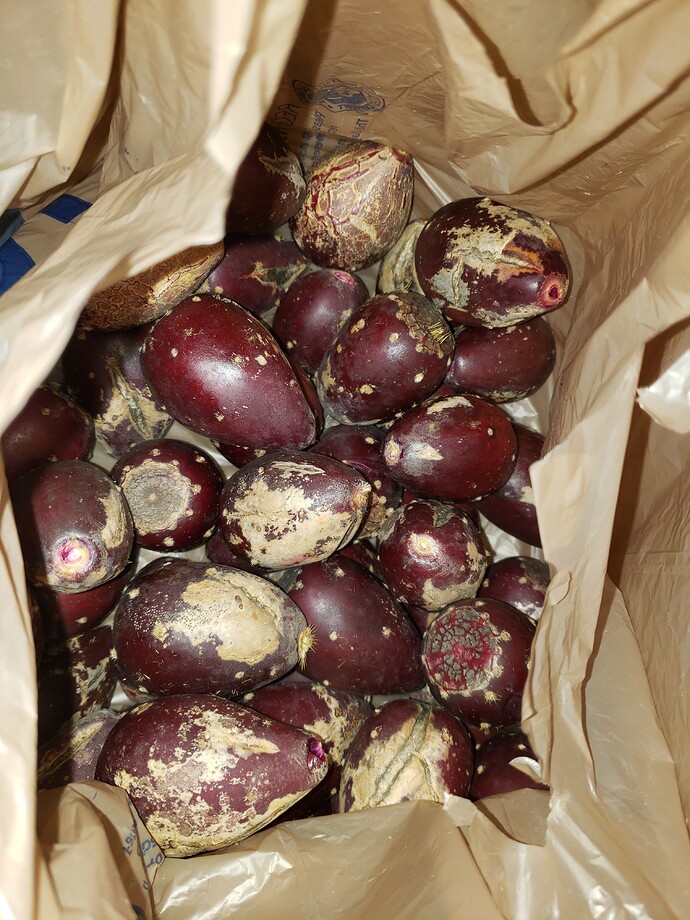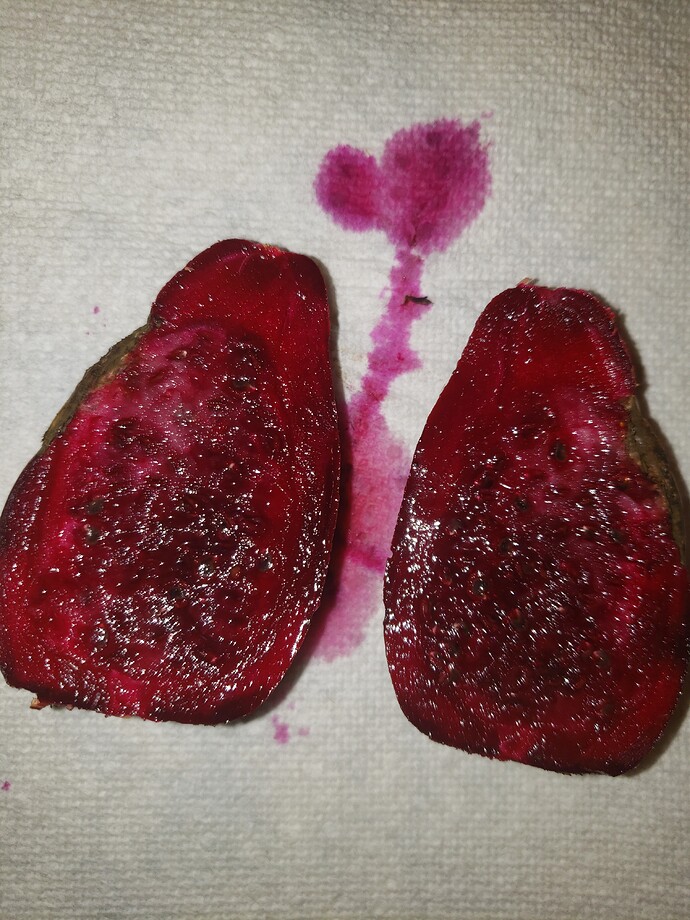Thanks for the pics! That is some good fruit variation. Have you tried eating any of them? Mississippi Unk. and Oklahoma Pancake look like O engelmanii to me. Maybe Mesa sky, too, but that could be a large-padded O macrorhiza or phaecantha. Engelmanii is supposed to be less hardy than O humifusa, but I had a cutting of an Arizona specimen outside in a pot in Kansas that leads me to believe it can handle at least to 6A, which is better than it’s usually given credit for.
Per the coldhardycactus website, Oklahoma pancake is O. gilvescens and Mesa Sky is O. phaeacantha. No clue what the Mississippi one is, got it in a trade years ago. It suffers some winter injury each year, so I’d say it’s zone 6/7 hardy.
I might try a few this weekend once I finish getting glochids out of my hands.
I suspect they’d know better than I do. USDA lists gilvescens as a synonym of phaecantha, but I’d believe it either way. Good luck with the glochids!
Thanks for all the info! Where I work I have been drooling over some quart containers of
O. humisifolia for a few months. At $11 each I was wondering how they would work.
I recall in youth a friend of mine in SE WI had a pile of prickly pear on the south side of their house. I was dumbfounded that a cactus could survive our winters but they did.
Years later I found historical records of when Wisconsin was surveyed in the 19th century and the surveyors marked native prickly pear in several areas of my home state.
I always wondered if any of these native sites still existed with them.
I think I will have to plant two on the south side of my brick house. Nice and hot there in the summer time.
Our tunas out west seem generally to be larger than the eastern ones. This is a variety from Chile, grown in SoCal. Called tuna de Tiltil, or melon tuna. Excellent flavor reminiscent of honeydew melon…
Here’s a variety I picked up off the street in a Chicano area of La Habra, CA. Its pads are particularly good as a vegetable. Flavor of the fruit is also excellent.
From Chile
From La Habra
Excellent vegetables!
I use a dry fibrous plastic scouring pad to knock off the spines. Quick and easy. Dry wadded paper towels will also work, but not as well, and they don’t last well if you’re doing a lot of them. Wear gloves.
Ah, man. Now you’re just making us jealous! Nice tip on the spine removal techniques. I’ll have to give them a try.
I may have to revise my statement on the skin vs. pulp. @ampersand was kind enough to send me some cuttings of Oklahoma Pancake and Barr’s Dwarf. Barr’s had some fruits on it, which I tried, of course. Interestingly, the skin section had that punchy flavor that is only in the pulp on the cactus I have already. So, even though the fruit is smaller, it makes for a good eating fruit as the inner pulp and the fleshy skin both have a similar flavor. Just pop it in your mouth (sans spines) and you’re good to go! I look forward to trying out the Oklahoma Pancake fruits in the future.
Cleaning up my cactus bed a little today and I found 3 or 4 tiny seedlings. Does anyone want them? I suspect they were from Mesa Sky, that’s the variety directly above the seedlings. Seedlings are are maybe an inch tall.
I’ve tried the ones off Opuntia engelmannii down South. They are larger, about egg-sized. But also with the same pesky glochids and frankly, their taste was watery, but pretty bland…sort of like an unripe watermelon close to the rind.
Now, it is still a nice cactus with beautiful blooms…but after that one experience, I didn’t think the juice was worth the squeeze, as far as consumption?
I’m not sure what kind we have but our prickly pears really took off in pots on our deck this summer.
I wanted to add an interesting observation on rooting pads. @ampersand was kind enough to share some pads of Oklahoma Pancake and Barr’s Dwarf, and I rooted them in pots inside along with a few pads from my Long Island sourced plants. There was a lot more variation in how easily they rooted than I expected. The Long Island pads rooted in 2-3 weeks, Oklahoma Pancake took another 2 weeks, and Barr’s Dwarf wouldn’t throw any roots until I put it on bottom heat. Normally, I would root these outside in the summer, but I wanted them to have some roots before storing them on the closed porch for the winter. If placed on the ground in the warm months, I doubt Barr’s would have any trouble rooting.
I think there are some bluffs in Western Wisconsin where cacti are native. It seems I went there with a college botany class years ago, but I forget where it was.
Yes, Barr’s Dwarf is a shy rooter and very slow grower!
Funny this came up. The lady who watches my son is from the Caribbean and has a couple plants that fruit prolifically. Just made a large quantity of jam, have a huge bag full left, and she has tons more left. I compare it to one from the store and the store variety “juanita?” Iirc from Mexico had smaller seeds.
The fruit has a sweet melon taste. With the lemon/ citrangequat juice added to the jelly, its very tropical tasting. She juices them and drinks them every morning.
What variety should I seek for large and flavorful fruit that is cold hardy to zone 7? The ones I have are an unknown variety and seem to produce very small fruits. They are good just too small for my liking. That Juanita looks tempting but I can’t find them online.
I’m pretty sure there aren’t any that check all those boxes. All the varieties like you see in the supermarket are hardy to zone 9, I believe. Maybe some 8s. There are some more southern species that might be hardy to zone 7 that give fruits maybe half that size. Alternatively, if you have space for a greenhouse, you could probably make a zone 9 climate without too much trouble.
I do think there’s some potential for hybridizing the largest-fruited specimens of the northern species with the commercial varieties. I would expect the fruits to be somewhat smaller, as there would be a ploidy difference, among other reasons. No one has worked on this to my knowledge, but I hope to try it out if I can get my O ficus-indicum to flower and fruit.
@manfromyard 's friend’s plant looks intriguing. It could be one of the SE native species that have intermediate size fruit. How large are they? And does she grow the plant outside? If the fruit is larger than 2" long with that shape and growing in zone 7, it’s probably worth propagating. I’m also curious about the seed to pulp and skin to pulp ratios. Could you post a picture of one cut in half?











